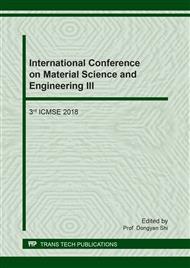p.109
p.115
p.120
p.126
p.132
p.137
p.144
p.148
p.154
Effect of Rotating Tool Geometry on Mechanical Properties of Friction Stir Welded Aluminum Alloy 2195
Abstract:
It is known that Al-Li alloys show high specific strength and have been used in space vehicles with Friction stir welding (FSW). FSW has many advantages including the absence of porosity, low distortion and reduced residual stresses which are typical defects of the fusion welding processes. The process uses a rotating tool with a profiled pin that penetrates the parts to be welded. The tool starts to travel along the welding line and the softened material due to the frictional heat is stirred and mechanically mixed together by the rotating pin forming a weld in solid state without melting. Welding parameters such as tool rotational speed, travelling speed, and tool geometry are the main parameters which affect the material flow and the heat generation rate. The important tool geometry includes pin size and shape, pin tread and pitch, tool materials, and shoulder size and shape. The present work is to study the effect of tool geometry on the microstructure and mechanical properties of friction stir welded aluminum alloy 2195. Five different tool profiles have been used to investigate the effects of tool geometry on mechanical properties. The experimental results show that aluminum alloy 2195-T8 can be welded using FSW process with maximum welding efficiency of 75% using threaded cylindrical with concave shoulder at rotation speed, 600 RPM and welding speed, 300 mm/min.
Info:
Periodical:
Pages:
132-136
Citation:
Online since:
October 2018
Authors:
Keywords:
Price:
Сopyright:
© 2018 Trans Tech Publications Ltd. All Rights Reserved
Share:
Citation:


